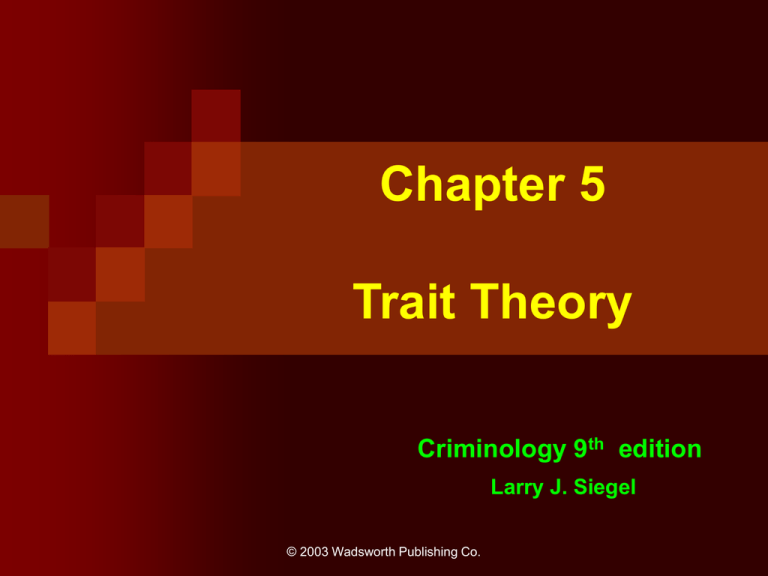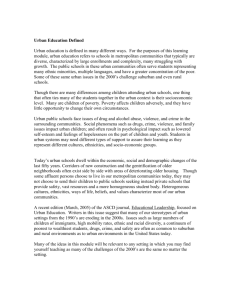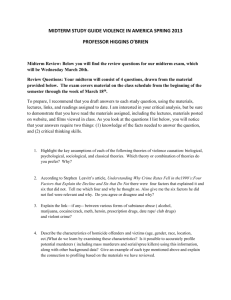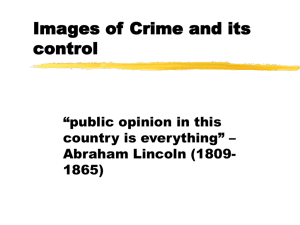Chapter
advertisement

Chapter 5 Trait Theory Criminology 9th edition Larry J. Siegel © 2003 Wadsworth Publishing Co. Question Do you think that people who commit crime are physically or mentally abnormal? Trait Theories Trait theories are made up of biosocial and psychological theories. The primary focus of trait theories is human behavior and drives, i.e., aggression, violence, and a tendency to act on impulse – factors that are linked to antisocial behavior (as opposed to legally defined criminal acts). Biological and Psychological Traits Both biological and psychological traits have been linked to criminal behavior, but not as causal linkages. It is the “multiple factor” approach or the interaction of mental and physical traits with environmental and social factors that either suppress or trigger criminal behavior. The focus is generally on persistent or chronic offenders. Foundations of Biological Trait Theory Biological explanation of criminal behavior first became popular during the middle part of the 19th Century with the introduction of positivism. What is positivism? Positivism Positivism rejects the concept of free will. Crime can only be understood if it is studied by the scientific method. Human behavior is a function of internal and external forces, i.e., social, biological, psychological, or economic forces. Early Positivists Early positivists included: Lombroso - belief that certain physical characteristics indicate a criminal nature, i.e., atavistic anomalies. Garofalo - certain physical characteristics and psychological characteristics indicate criminal nature, i.e., prisoner tattooing. Ferri – belief in biological, social and organic factors as a cause of crime and delinquency, i.e., forces outside your control. Sheldon - belief in body types which were susceptible to certain types of delinquent behavior, i.e., somatotype school. Problems With Early Positivist Theories The research of the earliest positivists (who were biologists) was plagued by poor: Methodology Testing Logic Biosocial Trait Theories Biochemical Conditions and Crime Neurophysiological Conditions and Crime Genetics and Crime Evolutionary Views and Crime Biosocial Perspectives on Criminality Principles of Biosocial Trait Theories Genetic makeup contributes significantly to human behavior. Not all humans are born with equal potential to learn and achieve (equipotentiality). No two people are alike (with rare exceptions, i.e., identical twins), thus the combination of genetic traits and the environment produces individual human behavior patterns. How do these principles contrast with social theories? Question How does a biosocial theorist explain learning? Biosocial Theory: Biochemical Perspective CAUSE Crime, especially violence, is a function of diet, vitamin intake, hormonal imbalance, or food allergies. STRENGTHS Explains irrational violence. Shows how the environment interacts with personal traits to influence behavior. Question Is there a link between sugar and antisocial behavior? If so, explain. What is the link between hormones and antisocial behavior? Explain. Biochemical Considerations Aggression and violence have been linked to diet. Some believe diets high in sugar and carbohydrates are culprits. What do studies show? Biosocial Theory: Neurological Perspective CAUSE Criminals and delinquents often suffer brain impairment, as measured by the EEG. Attention deficit disorder and minimum brain dysfunction are related to antisocial behavior. STRENGTHS Explains irrational violence. Shows how the environment interacts with personal traits to influence behavior. Neurological Impairment Neurophysiology – the study of brain activity suggests that physical and brain abnormalities are acquired at the prenatal stage or through birth delivery trauma – in turn, they control behavior throughout the life span. What is the link between brain chemistry and chronic offenders and crimes of violence? Biosocial Theory: Genetic Perspective Cause The major premise is that criminal traits and predispositions are inherited. The criminality of parents can predict the delinquency of children. Strengths Explains why only a small percentage of youth in a high-crime area become chronic offenders. What do the results of sibling and twin studies show? Contagion Effect? Biosocial Theory: Evolutionary Perspective Cause As the human race evolved, traits and characteristics have become ingrained. Some of these make people aggressive and predisposed to commit crime. Strengths Explains high violence rates and aggregate gender differences in the crime rate. Explain why violence is often driven by evolutionary and reproductive factors. Question If there is a biological basis to violence and aggression – then how would a biosocial theorist explain white collar crime? Evaluation of Biosocial Trait Theory Criticisms If there are biological explanations for street crimes then by implication biological theory says that member of groups are biologically different, flawed or inferior. The is also a lack of adequate empirical testing. Response Rather than suggest that there are born criminals and non-criminals, proponents maintain that some people carry the potential to be violent or antisocial and that environmental conditions can sometimes trigger antisocial responses. Psychological Trait Theories Social Learning Mental Illness and crime Personality and Crime Intelligence and Crime Psychodynamic Behavioral Cognitive Psychological Perspectives on Criminality Psychological Theory: Psychodynamic Perspective Major Premise….. The development of the unconscious personality early in childhood influences behavior for the rest of a person’s life. Criminals have weak egos and damaged personalities i.e., anger, sexuality, tendencies. Created by Sigmund Freud. Strengths Explains the onset of crime and why crime and drug abuse cut across class lines. What type of mood and/or behavioral disorders may affect offenders? Crime and Mental Illness A great deal of early research efforts found that many offenders who engage in serious, violent crimes suffer from some sort of mental disturbance. However, empirical evidence has contradicted this. Research shows that upon release, prisoners who had prior histories of hospitalization for mental disorders were less likely to be rearrested than those who had never been hospitalized. Mentally disordered inmates who do recidivate upon release appear to do so for the same reasons as the mentally sound. Psychological Theory: Behavioral Perspective Major Premise….. People commit crime when they model their behavior after others they see being rewarded for the same acts. Behavior is reinforced by rewards and extinguished by punishment, i.e., learning processes. Strengths…. Explains the role of significant others in the crime process. Shows how family life and media can influence crime and violence. What is social learning theory? Social Learning Theory (Life Experiences) An event that heightens arousal Behavior and values become consistent Factors that help produce violence and aggression. Expected outcomes rewards Learned aggressive skills Psychological Theory: Cognitive Theory Major Premise Individual reasoning processes influence behavior. Reasoning is influenced by the way people perceive their environment and by their moral and intellectual development, i.e., thinking, memory, ethical values. Strengths…. Shows why criminal behavior patterns change over time as people mature and develop their moral reasoning. May explain the aging-out process. Explain the relationship of cognitive processes, perceptions, and chronic offending. Personality and Crime Personality can be defined as the reasonably stable patterns of behavior, including thoughts and emotions that distinguish one person from another. Personality reflects a characteristic way of adapting to life’s demands and problems. Psychopaths Anti-Social Personalities I Abnormal Affect Sociopaths Intelligence and Crime What is the difference between nature theory and nurture theory? Do you think IQ and crime are linked? Explain. If so, why are there more male than female criminals? or, Why does “aging out” occur?






